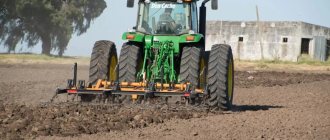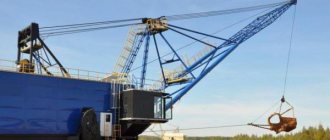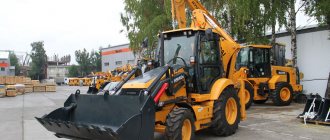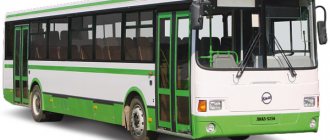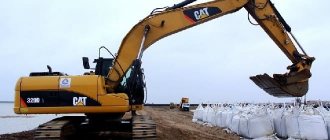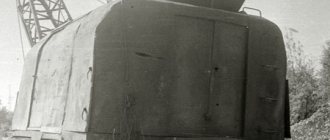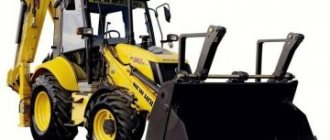Excavators are earth-moving machines that have different purposes. They can be used for digging quarries, holes for building houses, and also for mining. All mechanisms differ not only in technical characteristics, appearance, but also in size.
The top 10 includes the largest excavators in the world in the history of earthmoving.
No. 10: Hitachi EX8000-6
- Hitachi EX8000-6 - a modern hydraulic excavator from Hitachi opens the rating of large excavators.
The machine was built in 2012 for coal mining. Compared to other representatives of the rating, it cannot boast of very impressive dimensions, but despite this it has good performance. The mechanism is capable of lifting up to 75 tons at a time, and its power is 3880 horsepower. The height of Hitachi EX8000-6 is about 10 meters, and the length is more than 30 meters. The bucket volume of this model is 40 cubic meters.
Wheel excavator design
This earth-moving equipment is made in the form of a frame, which has a pneumatic wheel running device. There is also a rotating platform here. The platform usually has the ability to rotate completely. Thanks to this feature of the rotating platform, the device will stand still, and the bucket can rotate in any direction. For greater stability during loading, special outriggers are provided, called outriggers. Also, thanks to the presence of outriggers, the excavator will not slip while loading its bucket.
The weight of such excavators does not exceed 25 tons. Thanks to this, it can easily move around the city without causing damage to the road surface. Also, unlike tracked models, this version of construction equipment can reach speeds of up to 30 km/h.
It is worth noting that this technique can be supplemented with various hanging equipment. Then, if necessary, you can change its functionality, which will help significantly save money. But even with additional elements, it retains its original purpose and can at the same time be used as earth-moving equipment.
No. 9: Marion 6360
- Marion 6360 is one of the ten largest excavators in the world.
Its creator is the American company Marion Power Shovel, which was built in 1965. Merion's weight was about 13 thousand tons, and the length of its boom exceeded 67 meters. Eskazavr was in operation for more than three decades. It fell into disrepair after a malfunction occurred in the mechanism in 1991, which led to the spontaneous combustion of the car. Restoring the structure was considered impractical, so after this incident the legendary Marion 6360 was scrapped.
#6: Big Muskie
- Big Muskie is the world's largest walking excavator, created in the second half of the last century by the American company Bucyrus-Erie.
The total mass of the colossus is about 13 thousand tons. The Big Muskie is almost 68 meters high, more than 46 meters wide, and about 150 meters long. The dragline bucket volume is 168 cubic meters - an area that is enough to fit two buses. It took the company two whole years to build it, and its final cost was 25 million US dollars. Big Muskie needed to consume enough electricity to power about 30,000 apartments. The machine was in operation for 30 years. During this period of time, 20 million tons of coal were mined by dragline.
Komatsu, PC8000-6
The model of the hydraulic, crawler excavator R S 8000 is considered one of the largest in the line of Japanese earth-moving equipment. The machine is used in the metallurgical and mining industries, its operating parameters:
- power - 4200 hp;
- bucket volume - 36 m³;
- rotation speed of the working platform - 3.5 rpm;
- max depth of digging/cutting soil - 8.5 m;
- max lifting height of the bucket - 16 m;
- the running chassis consists of 2 side (body) tracks and one central track;
- operating weight - 720 tons.
No. 5: RH 400
- The RH 400 is the largest hydraulic excavator in the world, built by the German company O&K.
The weight of the mechanism is about 100 tons, and its power is 3.3 megawatts. The bucket of this model can hold about 50 cubic meters. The RH 400 is ready to work even in very harsh weather conditions, thanks to the developed oil heating system. Its engine power is 4,500 horsepower, and the unit’s fuel tank is designed to hold 15 thousand liters of fuel. The cost of one such copy will cost the buyer 14 million US dollars.
Criterias of choice
First of all, before purchasing, you should decide on the purpose for which a wheeled excavator will be needed. If the purchase is made by an organization, then in this case, most likely, a wider range of requirements for the work will be presented. When purchased by a private individual to carry out work for hire, the range of work performed will be significantly narrowed.
Having decided on the goals that will be achieved using this technique, you can move on to the size and power of the machine. The higher the weight of a given device, the more power it will have, but, therefore, the cost will also be higher. Keep in mind that a too bulky option will be inconvenient to do work in the city. And it doesn’t matter whether it’s a construction site or road work. Typically, such options are used in quarries. But a model that is too small may not cope with the tasks. It is also important how far the extended arrow can reach. If the work site differs significantly from the level of the equipment, then there is a risk that the bucket may not reach the required location. Typically this parameter is indicated in the device passport.
Also, do not forget to inquire about the engine power. Of course, the larger the car, the higher the power. But still, among equipment of the same size, choose the option with a more powerful engine. Thanks to this parameter, the speed and productivity of the services performed will be increased, and it will be possible to take on work in difficult conditions.
Since most models run on diesel fuel, they therefore pollute the environment with exhaust gases. Make sure the option you choose meets the regulations in your country or region.
Having decided on the technical characteristics, you should not forget about the ease of use of the equipment. Since the work performed can take more than one hour, the operator must have a comfortable chair. The control levers should be comfortable so that each operation does not require a lot of force. The work performed can be quite noisy; for this, the cabin must have sufficient sound insulation.
#4: Bagger 293
- Bagger 293 is one of the largest mining excavators in the world, listed in the Guinness Book of Records.
The weight of the mechanism is 14 tons, the height is equal to a thirty-story building, and its length is more than two hundred meters. Bagger 293 was built specifically for quarrying. A team of five people works to operate the machine. The unit moves at a speed of just over 6 km per hour. Every day this machine is capable of shoveling about 3 million cubic meters. In a day's work, the Bagger 293 can dig a hole the size of a football field. On board the special vehicle there are lifting mechanisms and workshops for its repair.
Crawler mining excavators. With 85 years of history
Let us tell you the story of the appearance of another mining excavator in demand today. Its production began in the pre-war years. The first model was the M-IV-E (IV-M-3), released in 1936, designed in Leningrad and marking the beginning of the Soviet heavy excavator industry. This is an electric full-rotary shovel machine equipped with a standard or extended boom and a 3 or 2 cubic meter bucket respectively. The power of the network three-phase motor was 250 kW.
Photo source: techstory.ru Tests of the M-IV-E mining excavator, 1936
Read
Before and after: photographs of bulldozers decades later
During the Great Patriotic War, the production of excavators was discontinued. Production was resumed only a few years after its completion, in 1947. At the same time, a significantly improved model began to be produced under a new name - E-3, later - SE-3. The history of the appearance of the letter “C” in the index is as follows: the group of designers who developed this model received the Stalin Prize. The surname of Boris Ivanovich Satovsky, the leader of the group, was included in the name of SE-3.
The 165-ton excavator was equipped with a 3 cubic meter bucket designed for harsh operating conditions. At the same time, buckets of 4 or 5 cubic meters could be installed on the machine. without the need to make changes to the design of the equipment. In comparison with the predecessor model, the power of the SE-3 engine was increased to 340 kW.
Photo source: techstory.ru Loading soil with a SE-3 mining excavator into a MAZ-525 dump truck, 1947
After some time, the EKG-5A excavator was released, which, by the way, is still produced today. The machine is a full-rotary shovel with an electric drive and caterpillar drive. The weight of the excavator was increased to 196 tons, and the bucket volume was increased to 6.3 cubic meters. The engine power, like the very first model, is 250 kW.
The modern machine comes with a boom length of 11.2 m, while the length of the SE-3 boom was 10.3 m. The maximum unloading height of the EKG-5A is lower than that of its predecessor - 6.7 m and 7.1 m, respectively.
Photo source: techstory.ru Has been in production for over 40 years. Quarry excavator EKG-5A
The temperature range at which uninterrupted operation of equipment is possible ranges from -40 to +40 degrees. At the same time, various modifications allow the machine to operate in arctic (up to -60 degrees) or tropical (up to +50 degrees) climate.
Photo source: uralmash-kartex.ru Weighing almost 200 tons. Modern EKG-5A from Uralmashzavod
No. 3: R&N4100XRS
- R&N4100XRS is the largest Russian mining excavator.
The mass of the giant machine exceeds 1.5 tons, and the bucket volume is 57 cubic meters. In a year, R&N4100XRS can process 200 million tons of rock, for the removal of which six huge BelAZ trucks weighing 320 tons are used. The owner of the unit is. Using an excavator, the company manages to extract up to 15 million tons of coal per year. The R&N4100XRS is well worth the money that we had to pay for it - its purchase cost the company 575 million rubles. This design can replace four conventional excavators. The machine is operated by two excavator operators, for whom there is also a place for rest and a toilet in the cabin.
Principle of operation
This equipment is controlled from the cab by an operator with special rights. The cab has a seat for the operator and a control panel. Since the process produces a lot of noise, the cabin is soundproofed. The control panel contains instruments that control the work process and safety. The design of wheeled excavators uses a hydraulic system, so control does not require much effort.
So, the operator using the panel can perform the following operations:
- Collect soil using a bucket;
- Move it to the required distance;
- Unload the soil to the required location.
It should also be taken into account that this type of equipment can work both with soil and hard rocks. The equipment can be located at the same level with the working platform, or above or below the platform.
#2: Bucyrus RH400
- The Bucyrus RH400, also known as Big Brutus, is one of the largest excavators in the world, created by Bucyrus-Erie.
The machine was used for open-pit mining of coal. Big Brutus was able to mine rocks from a depth of more than 20 meters. The annual maximum productivity of the Bucyrus RH400 (assuming operation at full power) could be an area of 260 hectares. During this cycle, the colossus was capable of immediately filling 3 huge carriages. The weight of the car is about 900 tons, and the power of its engine is 4400 horsepower. The length of Big Brutus' tracks exceeds ten meters. Currently, this one-of-a-kind specimen is kept in the American Museum of West Mineral.
Types of excavators
First of all, this equipment should be distinguished by its purpose and operating conditions. During construction, universal models are usually used. They are of medium size, quite productive, and easily move from one object to another. For use in mines, small-sized models are used, this makes it possible to easily move in confined spaces. There are also models for use in a quarry; they usually have a large bucket to increase the volume of soil or rock being mined and loaded.
The next parameter in which these earth-moving devices differ is the operating principle. The most common option is a technique with a cyclic operating principle. Here the device has one bucket. The cycle consists of the following actions: loading, delivery to the unloading point and subsequent unloading. After this, the cycle repeats. There are also models with several buckets, here the principle of operation is continuous. The excavator has a rotary mechanism, with its help several buckets rotate, thereby increasing work productivity.
Also, cyclic excavators, in turn, are divided into several groups depending on additional equipment. To work with soil that is above the level of technology, models with a straight shovel are used. This shovel easily copes with any type of rock and copes well with the task of loading and unloading. If it is necessary to carry out work where the soil is below the level of technology, models with a backhoe are used. Such models dig the soil towards the excavator and are mostly used for digging trenches or foundation pits. To work at great depths, a model with great maneuverability is required. This is an excavator with a dragline, which is a device with a bucket placed on a rope that is suspended from a boom. Grab excavators are used for digging pits, operating under water and loading. If the object is on an inclined surface, then models with telescopic equipment are used. With their help you can easily level the territory.
Also, this version of earth-moving equipment may differ in the type of engine used. There are two options here: diesel and electric excavators. Diesel engines have a fairly high fuel consumption, but this pays off with their maneuverability, mobility and performance. Electric options are used in cases where equipment does not need to move from object to object.
#1: Bagger 288
- Bagger 288 completes the ranking of the largest excavators in the world.
It was built by Krupp in 1978. The customer of the machine was the mineral mining company Rheinbraun, which needed a unit that could work at very great depths. As a result, the cost of the car amounted to 100 million US dollars. An excavator mines so much rock per day that it would take about 4 thousand KAMAZ trucks to remove it.
Bagger 288 is equipped with 18 buckets, each with a volume of about 7 cubic meters and a height of about 2 meters. Every hour it can process about 10 thousand cubic meters of mined rock. The giant's height is almost 100 meters, and its length exceeds 200 meters. The weight of the entire structure is more than 13 thousand tons. At the same time, a team of four people works on the Bagger 288. The speed of movement of the colossus is only half a kilometer per hour.
Save and share:
